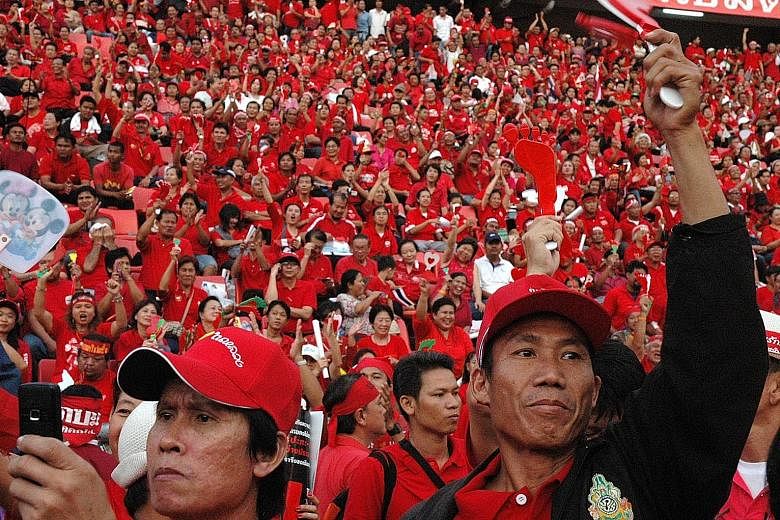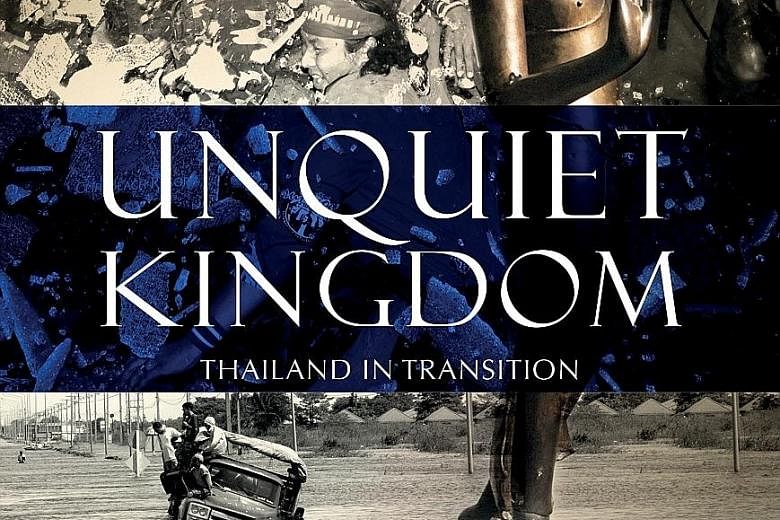On a particularly stifling September night in 2008, after months of political tension, things turned ugly on a much bigger scale, signalling what was to come in the months and years ahead.
I was alerted by a breathless midnight phone call from a friend, the German photographer and blogger Nick Nostitz. Hundreds of people were intent on attacking the People's Alliance for Democracy (PAD) encampment, he told me. I immediately rushed to Government House in the centre of historic Bangkok, where PAD protesters dressed in their yellow shirts had occupied the sprawling compound for weeks with makeshift barricades of concrete blocks and rolls of razor wire, manned by masked men armed with slingshots, golf clubs and baseball bats and, inevitably, guns, though they were rarely seen.
I had only just come off crutches after a motorcycle accident some eight months earlier had snapped my left leg, just above the ankle. I could walk, but only slowly. I could not run.
I arrived at the PAD camp and limped through it. The mood was serious and business-like. All the men at the barricades wore helmets and held baseball bats. Some had slingshots. Many had improvised riot shields. They were waiting.

From a distance, the sound of the pro-government crowd could be heard as they approached. I hurried to leave the PAD lines before I was caught in the middle. I walked into a broad empty avenue bathed in cold white light and headed towards the oncoming crowd. I could hear their angry tones in the distance, see the figures approaching. It was unsettling.
Just after 1 am, I came upon a thin double line of police with only riot shields and no weapons, strung across Rajdamnoen Avenue and facing the oncoming crowd. I estimated the crowd at between 4,000 and 5,000 - mostly men, but women and young people, too. We knew they had started arriving the previous day, trickling into Bangkok from across the north and north-east. Walking very fast, the vanguard of lean young men, many wearing red shirts and carrying two-by-four boards, slingshots, swords and rods, reached the line of police; in less than five minutes, the police allowed them through. Minutes later, the police simply walked away and watched from a distance as an almost mediaeval battle erupted.
Some in the mob began to run flat out, screaming, towards the PAD's sparsely manned outer perimeter. The few PAD guards that were there fled. The red shirts chased them, throwing aside metal barriers that clanged and bounced across the road. These were tough, tattooed young men there with the intent to start a fight. Only a few feet away, I flattened myself against a building as the rest of the mob charged at the fortress-like PAD encampment. From a distance of about 100m I watched as the PAD guards suddenly roared and came running out in a full charge, ploughing into the pro-government crowd, who were unprepared for the sudden, coordinated counter-assault. Simultaneously, several gunshots erupted from the PAD crowd. At least one pro-government protester fell immediately, I heard from eyewitnesses.
Once they heard the gunshots, many red shirts at the rear of the crowd began running helter-skelter as they realised PAD had the upper hand. A couple of bullets zinged into the trees above where I stood with a friend, Dan Ten Kate from Bloomberg News. He, Nick and I were the only foreign journalists there that night. At the sound of the first bullet, I ducked instinctively, though not knowing what exactly it was. At the second a severed branch fell from the tree under which we were standing, and the penny dropped. "Bullet!" I shouted, and we scrambled, bending low, to retreat.
WHEN PARLIAMENT FAILS
It was mayhem at this point, with panicked men from the pro- government mob running into alleys and trying to climb walls and breaking into buildings to get away from what appeared to be a well-armed counter-attack. I tried to run but could only hobble. I found a recessed doorway and pressed myself into it. I was wearing a media armband and hoped that it and my foreign appearance would protect me. A few metres up the road, the battle still surged, with a lot of shouting, loud bangs and the occasional gunshot.
Then the situation calmed momentarily. With sirens howling, ambulances raced to the site of the riot, taking some of the injured to hospitals. One PAD guard had been captured by the mob and was being hauled along the street and savagely jerked around like a rag doll, blood streaming from his face. Luckily, several people intervened to save him, and he was quickly bundled into an ambulance. The street was strewn with rubble from the fight. Broken glass, stones and bits of flower pots crunched under my boots. Several women sat on the sidewalks with their heads in their hands.
The pro-government crowd appeared stunned at being shot at by the PAD. One activist I knew spotted me and we talked briefly. "This is what we have descended to, when Parliament does not work any more, we become barbarians fighting in the streets," he said.
The PAD protesters had advanced several metres and now massed in the street in a show of strength. At 1.30am, a second wave of pro-government supporters appeared, a few dozen in number and armed with swords and other assorted weapons. This time, the police intervened more resolutely, forming a line across the road between the two warring sides. "Nobody is above the law," one pro-government man screamed at the PAD protesters. "Tomorrow we will bring many more people."
At around 2.45am, more than a hundred soldiers arrived with riot control gear but no weapons. Dressed in camouflage fatigues and holding riot shields, they fell in to support the police. By 3.30am, the chance of another clash appeared to have diminished. But the mood remained dangerously volatile.

This was a ragged crowd of mostly young men from upcountry villages and the slums and back streets of Bangkok, many, if not all, hired for the night. They were attacking a well-entrenched, well-resourced, well-kitted-out protest encampment occupying the seat of civilian power - Government House - dressed in yellow shirts and holding portraits of the King. Even in the dark it was not hard to see the contours of Thailand's class divide.
The "red shirt" movement supporting Thaksin began to take shape after that midnight clash on Rajdamnoen Avenue, which was a grim signal of what the future had in store. Among the jumble of items that emerged from my closet in Bangkok, as I packed up after 13 years of working there, was a red armband with a bold black drawing of an angry man's face, arm flexed, bicep bulging. It was issued to journalists as identification and accreditation for the red shirt rallies (most of us instead wore the green armbands jointly issued by the Thai Journalists Association and the police).This was the neo-revolutionary art that emerged in the ranks of the red shirts, who called themselves prai (slaves) fighting against the ammat (bureaucratic polity), a euphemism for the aristocratic, old-money Bangkok elites, liberally studded with royal titles and basking in the reflected glow of the monarchy in a feudal society only two generations into a transition to democracy.
TOXIC DIVIDE
The class divide aspect of the political conflict began to be better defined by 2009 and crystallised in 2010 on the morning of April 3. For weeks the red shirts had been encamped at Pan Fah bridge in Bangkok's government district, not far from the United Nations building. That morning, they suddenly relocated to the Ratchaprasong intersection in the city's shopping district.
Within an hour, convoys of vehicles descended on the upscale retail district and thousands of protesters settled into the intersection itself, right outside glitzy retail malls. Almost all them soon closed. This seemed almost a tit-for-tat response to the PAD's occupation of Suvarnabhumi International Airport two years previously.
The swarm into Ratchaprasong was festive and exuberant. Since their arrival in the city, the red shirts had been almost celebratory as they claimed territory, dancing to catchy traditional north-eastern mor lam music and rousing political songs. But when the first red shirts reached the intersection, they were confronted by a Thai youth who gunned his Porsche onto the pavement and smashed several parked motorcycles belonging to red shirt protesters. A fire hydrant stopped his car from doing further damage. The driver jumped out and struggled past several enraged red shirts and was bundled away by police, who later found a gun in the car. A red shirt schoolteacher from Bangkok who was at the scene told me, "They may have expensive cars, but they don't have brains. They need to respect different ways of thinking."
In the increasingly raucous, polarised online environment, PAD supporters even called the young man in the Porsche - whatever the circumstances of his rampage - a hero for challenging the red shirts. By 2010, the polarisation in the media had turned severely toxic. Invariably, the two sides, yellow and red, listened only to their own media, and all day long. There was no meeting ground. The Nation, an English daily newspaper, described a PAD march in 2006 that paralysed a good part of downtown Bangkok as a "historic march for democracy". When the red shirts arrived in the capital in 2010, the Bangkok Post condescendingly referred to the protesters as "rural hordes".
The occupation was peaceful, but the effect was probably as devastating as the airport occupation. Ratchaprasong is the heart of the humming capital's retail and hotel quarter. Within shouting distance of each other at that time were the Four Seasons Hotel (which later changed hands to the Anantara), the Grand Hyatt, the InterContinental and a clutch of luxury brand stores. The red shirt tent city sprouted on the sidewalks and on the street, and overhead on the walkways that connected the upscale malls and hotels with the Chidlom and Siam BTS or "Skytrain" stations. A few metres from bewildered restaurateurs offering salmon ravioli at 300 baht a plate, the protesters ate grilled chicken with spicy jin jaew sauce, given to them for free or a few baht per piece. The occupation threw a giant spanner into daily life of "hi-so" shoppers and working Bangkokians as well as well-heeled tourists and business travellers.
The divide was toxic. Each side demeaned and dehumanised the other. The red shirt protesters called Prime Minister Abhisit hia, or monitor lizard, a common insult. Bangkokian royalists called the red shirts khwai, or buffaloes. The more one side insulted and dismissed the other's point of view, the angrier the other got.
As I walked around the camped protesters in the shopping district, I was reminded of a phone call I received back in 2009, after the red shirts from upcountry had swarmed into the city. A Thai friend working as an executive in an international hotel chain was asking what I had been up to. When I said I had been covering the red shirts, she started shouting over the phone, "Who are these people? Where are they from? They are a small minority. They are uneducated, they are all paid, do you not understand?"
When I tried to explain that as a journalist I had to cover events like this and, moreover, that the red shirts were not a small minority, she hissed, "It is people like you who are encouraging them."


